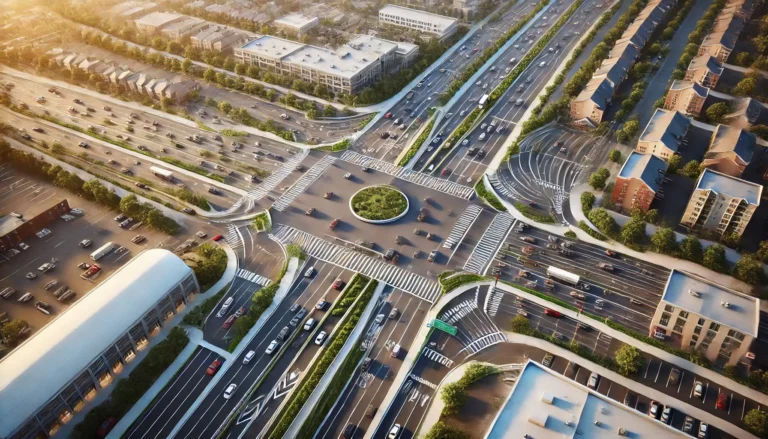Traffic congestion has been a persistent issue in many parts of the United States, especially in rapidly growing states like Virginia. In 2014, transportation authorities took a bold step toward improving traffic flow by implementing the Virginia Times Continuous Flow Intersection 2014 project. This innovative intersection design aimed to reduce congestion, improve safety, and optimize road efficiency.
As urban expansion increased traffic volumes, traditional intersections struggled to keep up. The introduction of a continuous flow intersection (CFI) provided a unique solution by modifying left-turn traffic movements, allowing for a more seamless driving experience. This article explores the design, impact, benefits, and challenges of this traffic innovation in Virginia.
Understanding the Continuous Flow Intersection
A continuous flow intersection (CFI) is a modern traffic design that improves road efficiency by rearranging left-turn movements before vehicles reach the main intersection. Unlike traditional intersections that rely on multiple signal phases for left turns, CFIs allow vehicles to cross opposing lanes in advance, eliminating the need for separate left-turn signals.
The result? Faster movement, reduced waiting times, and lower congestion. With improved signal coordination, CFIs enable a smoother traffic flow, particularly during peak hours.
In 2014, Virginia adopted this system in response to increasing congestion on key highways and intersections. By studying similar implementations in other states, transportation planners determined that CFIs could significantly improve road efficiency and safety.
Why Virginia Needed the Continuous Flow Intersection in 2014
Virginia has seen rapid population and economic growth, leading to increased traffic in urban and suburban areas. Many intersections experienced frequent bottlenecks, delays, and high accident rates due to inefficient traffic signal management. The Virginia Times Continuous Flow Intersection 2014 project was introduced to address these problems.
Key Reasons for Implementing CFIs in Virginia:
- Severe Traffic Congestion – Many of Virginia’s busiest roads faced heavy congestion, especially during rush hours.
- Frequent Traffic Accidents – Traditional intersections had multiple conflict points, leading to higher collision rates.
- Delayed Travel Times – Long wait times at intersections frustrated drivers and slowed economic activities.
- Growing Urban Expansion – Increased development called for innovative traffic solutions to support the growing population.
- Cost-Effective Infrastructure Improvement – Compared to large-scale road widening projects, CFIs offered a more affordable solution.
Virginia’s Department of Transportation (VDOT) recognized the need for a smarter, long-term traffic management strategy, leading to the development of CFIs in various locations across the state.
How the Virginia Times Continuous Flow Intersection 2014 Worked
Unlike conventional intersections that rely on multiple signal phases, a continuous flow intersection allows left-turning vehicles to move before reaching the main intersection. This eliminates unnecessary stopping and waiting, making the traffic flow more efficient.
Here’s how the Virginia Times Continuous Flow Intersection 2014 worked:
- Early Left-Turn Crossings – Instead of waiting for a separate green light, left-turning vehicles crossed opposing lanes ahead of the main intersection.
- Fewer Traffic Signal Phases – With left turns already out of the way, signals cycled faster, reducing delays.
- Better Traffic Distribution – Vehicles flowed continuously, preventing long backups and congestion.
- Enhanced Safety Measures – By reducing conflict points, CFIs lowered the risk of side-impact collisions and pedestrian accidents.
Virginia’s first CFI locations, such as Zion Crossroads, became key examples of this successful traffic solution.
The Impact of CFIs on Traffic in Virginia
Following the introduction of the Virginia Times Continuous Flow Intersection 2014, significant improvements were observed in traffic flow, safety, and commuting times.
Key Improvements Noted After Implementation:
✅ Reduced Traffic Delays – Studies showed a 20-50% decrease in wait times at intersections with CFIs.
✅ Lower Accident Rates – Fewer collision points resulted in a decline in traffic accidents, especially at high-risk intersections.
✅ Improved Road Efficiency – Vehicles moved faster, reducing congestion during peak hours.
✅ Environmental Benefits – Less time idling at signals led to reduced fuel consumption and lower emissions.
✅ Positive Driver Feedback – Although initial adaptation was challenging, most drivers appreciated the smoother traffic flow over time.
While the early phases required driver education and signage improvements, the benefits quickly became evident.
Challenges and Public Perception
Despite its advantages, the Virginia Times Continuous Flow Intersection 2014 project faced some initial challenges:
- Driver Confusion – Many motorists were unfamiliar with CFIs, leading to hesitation and adjustment periods.
- Pedestrian Safety Concerns – Some critics worried about pedestrian crossings due to the new traffic patterns.
- Construction and Implementation Costs – While cost-effective compared to major highway expansions, CFIs still required initial investment and infrastructure modifications.
- Traffic Pattern Adjustments – Nearby roads had to be adjusted to accommodate the new traffic flow system.
However, public perception improved as drivers became accustomed to the intersection design and witnessed its long-term benefits.
Future of Continuous Flow Intersections in Virginia
Following the success of the Virginia Times Continuous Flow Intersection 2014, transportation planners have continued exploring CFIs for other high-traffic areas in the state.
- Expansion to Other Regions – More cities and suburban areas are considering CFIs as a sustainable traffic solution.
- Integration with Smart Traffic Systems – Future plans include real-time traffic monitoring to optimize flow efficiency.
- Public Awareness Campaigns – Educating drivers and pedestrians will enhance safety and reduce confusion about CFI navigation.
Virginia’s approach to continuous flow intersections has set an example for other states, proving that innovative road designs can greatly improve urban traffic conditions.
FAQs About Virginia’s Continuous Flow Intersection
1. What is a continuous flow intersection?
A continuous flow intersection is a traffic design that moves left-turning vehicles across opposing lanes before reaching the main intersection, reducing congestion and wait times.
2. Why was the Virginia Times Continuous Flow Intersection 2014 implemented?
It was introduced to reduce traffic congestion, minimize accident risks, and improve road efficiency in high-traffic areas.
3. Did CFIs improve traffic flow in Virginia?
Yes, CFIs significantly reduced wait times, improved vehicle movement, and decreased collision rates at intersections.
4. Were there any challenges with CFIs?
Initially, drivers found CFIs confusing, but with time and education, they adapted, and traffic efficiency improved.
5. Are there plans for more CFIs in Virginia?
Yes, transportation officials are considering expanding CFIs to other regions to manage increasing traffic demands.
Conclusion
The Virginia Times Continuous Flow Intersection 2014 was a transformative step in the state’s approach to traffic management. By reducing congestion, improving safety, and enhancing road efficiency, CFIs have proven to be a valuable infrastructure upgrade.
While initial challenges existed, the long-term benefits outweighed the drawbacks, making CFIs an effective solution for Virginia’s growing transportation needs. As the state continues expanding and modernizing its roads, continuous flow intersections will play a key role in shaping the future of traffic management.

